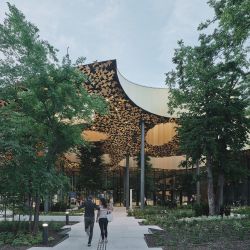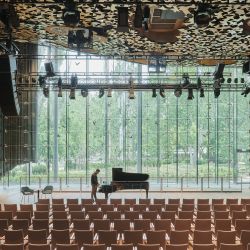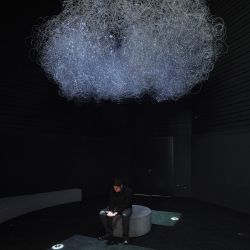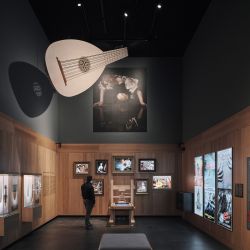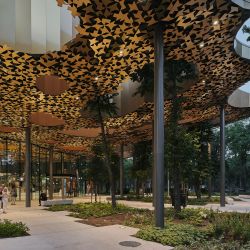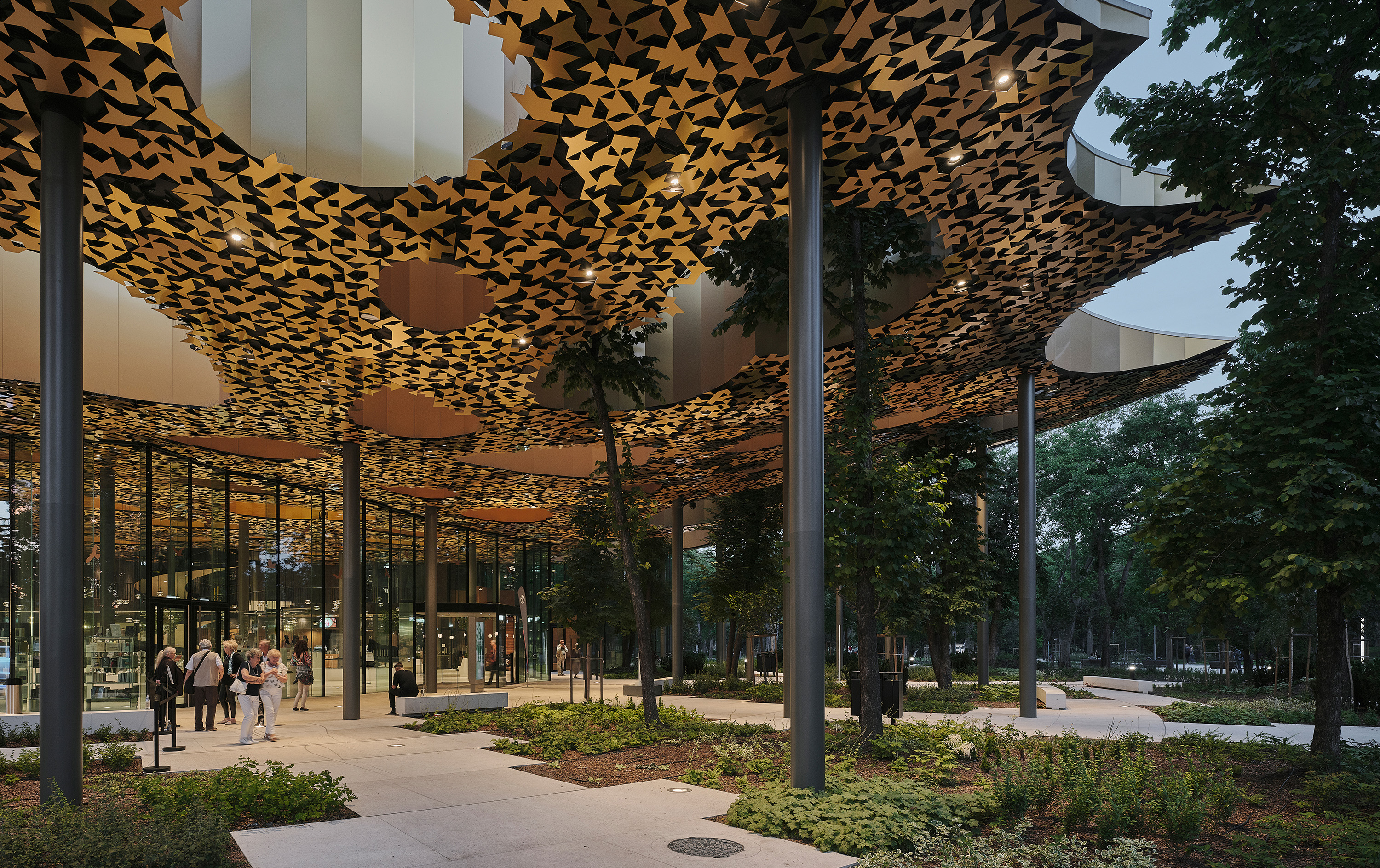
Download this article:
The "House of Hungarian Music" nestles like a futuristic oversized mushroom in the 'Városliget' forested park of Budapest. Japanese architect Sou Fujimoto completely redefines the boundaries between indoors and outdoors and between architecture and nature – by almost nullifying them. Sustainable lighting from ERCO is part of the innovative pavilion architecture, and precise light control and high visual comfort are cornerstones of the lighting design.
The World's Fair was held in the historic park in 1896, and now an ambitious cultural forum with numerous museum buildings is being built on obsolete and unused Expo sites. The House of Hungarian Music is the most spectacular new building of the "Liget Budapest Project" with a budget in billions. The 836 square metre music pavilion combines various exhibition and event spaces, offices, a library and two outstanding concert halls under its projecting, organically curved roof structure.
High visual comfort in glass architecture
Within the weightless pavilion architecture, visitors can believe themselves to be in a clearing in the middle of the forest. All boundaries between the interior and exterior seem abrogated. The striking canopy structure, supported by elegant pillars, is perforated by a total of one hundred crater-like cavities, akin to a Swiss cheese. Like in a fantastic greenhouse, trees grow through the cavities. Daylight thus also reaches down even into the basement. "We wanted to transform forest into architecture" stated Fujimoto, an architect renowned for poetic nuances, about his artistic intention. The transparent architecture was the determining parameter for the lighting concept. ERCO downlights were installed in the all-side glazed music pavilion to avoid glare and disruptive reflections. Good glare control ensures maximum visual comfort. The lighting targets sustainability throughout, and also contributed to the House of Hungarian Music receiving an excellent to very good BREEAM rating.
Precise light from a height of 12 metres
In the foyer with a ceiling opulently decorated by 30,000 specular gold leaf-like ornaments, 350 ERCO Gimbal recessed spotlights provide glare-free general lighting: the Gimbal luminaires, with focused light, imitate the incidence of natural light rays without illuminating the leaf ornaments themselves. The cardanic mechanism enables the luminaires to be precisely aligned to the gaps in the complex ceiling structure.
With a ceiling height of 12 metres, precisely directed light is essential. This is the only way to prevent light spill, which on the one hand causes glare and thus destroys the atmosphere of the architecture, and on the other hand also means wasted energy. ERCO luminaires function with projecting optical systems that direct the light with high precision – and thus still achieve high illuminance levels (lx/W) from large distances even with a low connected load. This creates the basis for sustainable lighting in which light is only used where it is needed, i.e. where human perception requires it.
In the basement, a permanent interactive, multimedia exhibition documents the history of European and Hungarian music. Here, too, high rooms characterise the architecture. This exhibition, as well as numerous screens in the exhibition areas, also had to be taken into account in the lighting concept. ERCO Optec spotlights for track were used because they provide precisely accentuated lighting even at a room height of seven metres. The light is directed precisely and exclusively to the target areas, precisely where required by the visitors. This approach not only underlines a responsible use of energy because light is omitted wherever it is not needed, it is also part of the exhibition concept: the multimedia screens, illuminated without disturbing reflections, stand out from the darkness to create a dramatic effect.
Zero light pollution
The outdoor lighting had to comply with strict regulations against light pollution – neither trees nor sky could be directly illuminated in the Városliget park. 100 ERCO Tesis ground-recessed luminaires illuminate the shiny gold leaf canopy of the glazed foyer from outside, providing poetic, indirect lighting. The precisely directed light always remains below the roof construction without entering the upper hemisphere, thus avoiding light pollution. With playful ease, the glass pavilion succeeds in creating a symbiosis between architecture, light, music and urban woodland. Just a few minutes' walk from Budapest's city centre, the House of Hungarian Music represents a fabulously different and sonically inspiring world.
Project data
Architecture: Sou Fujimoto, Sou Fujimoto Architects, Tokyo / Japan, M-Teampannon Kft., Budapest / Hungary
Elkectrical engineering: Hungaroproject Kft., Budapest / Hungary
Photography: David Schreyer, Graz / Austria
Products: Gimbal, Optec, Pantrac, Parscan, Pollux, Quintessence, Tesis, Skim
Photo credits: © ERCO GmbH, www.erco.com, Photography: David Schreyer
About ERCO
The ERCO Light Factory in the German town of Lüdenscheid is a leading international specialist in architectural lighting using LED technology. The family business, founded in 1934, now operates as a global player with independent sales organisations and partners in 55 countries worldwide. Since 2015, ERCO’s portfolio has been 100% LED. With this in mind, ERCO in Lüdenscheid develops, designs and produces digital luminaires with focus on photometrics, electronics and design. Working closely with architects, lighting designers and engineers, ERCO develops lighting tools used primarily for applications in the following fields: Work and Culture, Community and Public/Outdoor, Contemplation, Living, Shop and Hospitality. ERCO understands digital light as the fourth dimension of architecture – providing highly precise and efficient lighting solutions to support creative designers in turning their visions into reality.
If you require any further information on ERCO or image material, please visit us at press.erco.com/en. We can also provide you with material on projects worldwide for your media coverage.
Relevant image material
© ERCO GmbH, www.erco.com, photography: David Schreyer
© ERCO GmbH, www.erco.com, photography: David Schreyer
© ERCO GmbH, www.erco.com, photography: David Schreyer
© ERCO GmbH, www.erco.com, photography: David Schreyer
© ERCO GmbH, www.erco.com, photography: David Schreyer
© ERCO GmbH, www.erco.com, photography: David Schreyer
